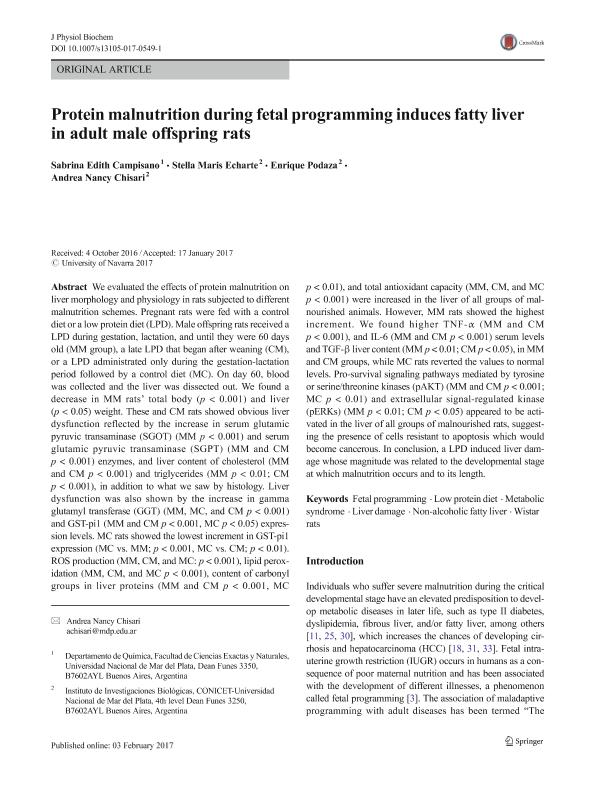Artículo
Protein malnutrition during fetal programming induces fatty liver in adult male offspring rats
Fecha de publicación:
05/2017
Editorial:
Servicio Publicaciones Universidad Navarra
Revista:
Journal Of Physiology And Biochemistry
ISSN:
1138-7548
Idioma:
Inglés
Tipo de recurso:
Artículo publicado
Clasificación temática:
Resumen
We evaluated the effects of protein malnutrition on liver morphology and physiology in rats subjected to different malnutrition schemes. Pregnant rats were fed with a control diet or a low protein diet (LPD). Male offspring rats received a LPD during gestation, lactation, and until they were 60 days old (MM group), a late LPD that began after weaning (CM), or a LPD administrated only during the gestation-lactation period followed by a control diet (MC). On day 60, blood was collected and the liver was dissected out. We found a decrease in MM rats’ total body (p < 0.001) and liver (p < 0.05) weight. These and CM rats showed obvious liver dysfunction reflected by the increase in serum glutamic pyruvic transaminase (SGOT) (MM p < 0.001) and serum glutamic pyruvic transaminase (SGPT) (MM and CM p < 0.001) enzymes, and liver content of cholesterol (MM and CM p < 0.001) and triglycerides (MM p < 0.01; CM p < 0.001), in addition to what we saw by histology. Liver dysfunction was also shown by the increase in gamma glutamyl transferase (GGT) (MM, MC, and CM p < 0.001) and GST-pi1 (MM and CM p < 0.001, MC p < 0.05) expression levels. MC rats showed the lowest increment in GST-pi1 expression (MC vs. MM; p < 0.001, MC vs. CM; p < 0.01). ROS production (MM, CM, and MC: p < 0.001), lipid peroxidation (MM, CM, and MC p < 0.001), content of carbonyl groups in liver proteins (MM and CM p < 0.001, MC p < 0.01), and total antioxidant capacity (MM, CM, and MC p < 0.001) were increased in the liver of all groups of malnourished animals. However, MM rats showed the highest increment. We found higher TNF-α (MM and CM p < 0.001), and IL-6 (MM and CM p < 0.001) serum levels and TGF-β liver content (MM p < 0.01; CM p < 0.05), in MM and CM groups, while MC rats reverted the values to normal levels. Pro-survival signaling pathways mediated by tyrosine or serine/threonine kinases (pAKT) (MM and CM p < 0.001; MC p < 0.01) and extrasellular signal-regulated kinase (pERKs) (MM p < 0.01; CM p < 0.05) appeared to be activated in the liver of all groups of malnourished rats, suggesting the presence of cells resistant to apoptosis which would become cancerous. In conclusion, a LPD induced liver damage whose magnitude was related to the developmental stage at which malnutrition occurs and to its length.
Archivos asociados
Licencia
Identificadores
Colecciones
Articulos(CCT - MAR DEL PLATA)
Articulos de CTRO.CIENTIFICO TECNOL.CONICET - MAR DEL PLATA
Articulos de CTRO.CIENTIFICO TECNOL.CONICET - MAR DEL PLATA
Articulos(IIB)
Articulos de INSTITUTO DE INVESTIGACIONES BIOLOGICAS
Articulos de INSTITUTO DE INVESTIGACIONES BIOLOGICAS
Articulos(IMEX)
Articulos de INST.DE MEDICINA EXPERIMENTAL
Articulos de INST.DE MEDICINA EXPERIMENTAL
Citación
Campisano, Sabrina Edith; Echarte, Stella Maris; Podaza, Enrique Arturo; Chisari, Andrea Nancy; Protein malnutrition during fetal programming induces fatty liver in adult male offspring rats; Servicio Publicaciones Universidad Navarra; Journal Of Physiology And Biochemistry; 73; 2; 5-2017; 275-285
Compartir




